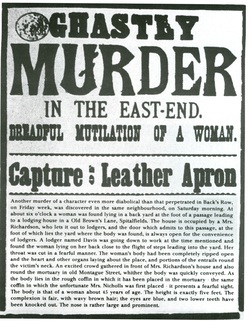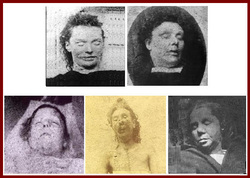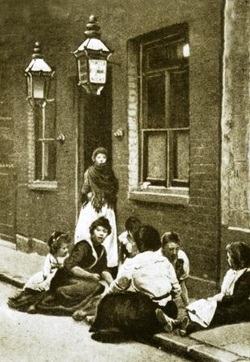The Setting

The name "Jack the Ripper" entails more than the name of a mystery murderer. As historians and investigators continue to attempt to fit the puzzle pieces of the 1888 criminal case, the victims and the violent acts committed against them remains a constant reminder of the horrendous impact one unknown individual can make on the district of Whitechapel in the city of London's East End.
The crimes committed by the mystery criminal all took place within a one mile area in East End's districts of Whitechapel, Spitalfields, Aldgate, and London Proper. Known for poverty and overpopulation, the area had a high concentration of drunkenness and prostitution, with an estimate of as many as 1200 prostitutes in the district. With the Victorian Era coming to a close in the late 1800's, the murders of Jack the Ripper ushered in a new age of crime. British crime historian Donald Rumbelow clarifies in his book that "Jack the Ripper inaugurates the age of sex crime" (Rumbelow viii). The killings also brought a new era with respect to media coverage. The press was responsible for may rumors and lies surrounding the mystery of the case, causing Whitechapel to be placed in the International spotlight.
The crimes committed by the mystery criminal all took place within a one mile area in East End's districts of Whitechapel, Spitalfields, Aldgate, and London Proper. Known for poverty and overpopulation, the area had a high concentration of drunkenness and prostitution, with an estimate of as many as 1200 prostitutes in the district. With the Victorian Era coming to a close in the late 1800's, the murders of Jack the Ripper ushered in a new age of crime. British crime historian Donald Rumbelow clarifies in his book that "Jack the Ripper inaugurates the age of sex crime" (Rumbelow viii). The killings also brought a new era with respect to media coverage. The press was responsible for may rumors and lies surrounding the mystery of the case, causing Whitechapel to be placed in the International spotlight.
The Crimes

Due to the high crime in the East End and the case remaining unsolved, it is not known how many victims were that of Jack the Ripper. Although there might be as few as four or more than seven, it is agreed that at least four women were murdered by the same killer and many include a fifth. Known as the "canonical five," these women all displayed common characteristics in their lifestyle and murders. The following victims (pictured from left to right):
- Mary Ann (Polly) Nichols - Died August 31, 1888
- Annie Chapman - Died September 8, 1888
- Elizabeth Stride - Died September 30, 1888
- Catherine Eddowes - Died September 30, 1888
- Mary Jane Kelly - Died November 9, 1888
Methods

With the exception of Mary Jane Kelly, all of the Ripper's victims were killed outdoors. Because the case continues to be analyzed in the twenty-first century, it has been determined based on the evidence and the crime scenes the method involved with each killing. Jack the Ripper would be facing his victim each time. Due to the drunken state most women were in and their profession, it is likely that at some point each women preceded to lift her skirt. At this time, the Ripper would grab the women by their throats and force death by strangulation. Once dead, the victim was placed on the ground to the killer's left. In every case it was found that this was the same placement based on the facts that with the body remaining in the position originally placed, the killer would have been unable to strike from the opposite side due to some type of blockage. Because blood was rarely splattered and instead coalesced in a pool, the victims throats were cut from left to right after they were placed on the ground. From the manner in which they were cut, it is believed that Jack the Ripper was left-handed. After this, organs were removed. It is believed the motive behind organ removal was for the organs to serve as a "trophy" for the killer. The removal of the kidney could also be tied to Biblical Old Testament references to the kidney containing the conscience and the emotions of an individual.
